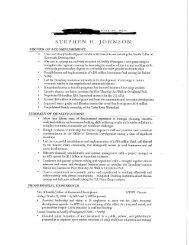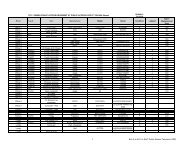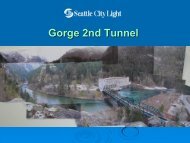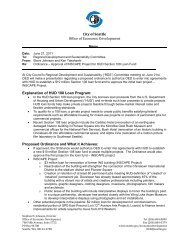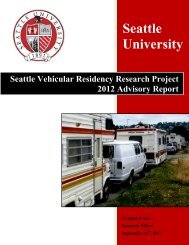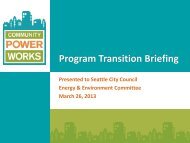2013 Water System Plan, Volume II - Seattle City Clerk's Office - City ...
2013 Water System Plan, Volume II - Seattle City Clerk's Office - City ...
2013 Water System Plan, Volume II - Seattle City Clerk's Office - City ...
You also want an ePaper? Increase the reach of your titles
YUMPU automatically turns print PDFs into web optimized ePapers that Google loves.
The design engineer must carefully review the buried-to-aerial transition to ensure<br />
the pipeline will be able to handle ground movement from earthquakes. In most<br />
cases, a restrained joint with both rotational and expansion capabilities (e.g. a<br />
double ball expansion joint fitting) is recommended. See also DSG section 5.8.4,<br />
Seismic Design.<br />
Freeze protection design must be considered. Potential options include one or more<br />
of the following:<br />
1. Insulation of the pipe;<br />
2. Heat tape.<br />
3. In case of a temporary change in the way the pipe is used resulting in low flows<br />
consider installation of a system to allow a release of a small volume of water to a<br />
location that does not cause an environmental impact or safety hazards<br />
C. Temporary Supports during Construction<br />
Supporting existing utilities during construction can be difficult, but is necessary to<br />
ensure no damage occurs to the existing pipelines. Typically, the construction contractor<br />
is responsible for supporting all existing utilities throughout construction. The<br />
contractor must provide a support plan that is stamped by a Professional Engineer<br />
licensed in Washington State. SPU engineering and Field Operations and Maintenance<br />
will review temporary supports in the field and notify the contractor of deficiencies. SPU<br />
<strong>Water</strong> Operations staff does not direct repairs.<br />
The following is a list of cautions contractors must take to avoid damage to pipelines:<br />
5.6.3.7 Casing<br />
Contractors must not use chains to move or support any pipe materials because<br />
it will damage the pipeline.<br />
Contractors must not rest the pipe on any sharp or pointed objects, including<br />
the bucket of any equipment, single point supports, or rods.<br />
Pipelines must not be unsupported for a length longer than one stick of pipe or<br />
one joint.<br />
If the joints are not restrained, the contractor must ensure crew safety by<br />
restraining the pipe from movement, which could separate the joints.<br />
Pipelines must be supported in cradles or on wide support beams sufficiently<br />
spaced so the pipeline does not sag and cause undue stress on the joints or<br />
pipeline wall. This is especially important for cast iron with lead joints.<br />
Do not expose more than one unrestrained joint.<br />
Lead joint cast iron water mains must not be allowed to deflect while they are<br />
exposed.<br />
<strong>Water</strong> mains are installed in casings to protect the mains from excessive loads and to provide a<br />
means of replacing the pipe beneath structures such as rail road tracks. Casings also reduce the<br />
damage to facilities over the water main in the event of a leak or main break. Sometimes casings<br />
5-22 SPU Design Standards and Guidelines



